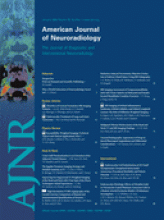Research ArticleHEAD & NECK
Radiation-Induced Xerostomia: Objective Evaluation of Salivary Gland Injury Using MR Sialography
A. Wada, N. Uchida, M. Yokokawa, T. Yoshizako and H. Kitagaki
American Journal of Neuroradiology January 2009, 30 (1) 53-58; DOI: https://doi.org/10.3174/ajnr.A1322
A. Wada
N. Uchida
M. Yokokawa
T. Yoshizako

References
- ↵Ship JA. Diagnosing, managing, and preventing salivary gland disorders. Oral Dis 2002;8:77–89
- ↵Vissink A, Burlage FR, Spijkervet FK, et al. Prevention and treatment of the consequences of head and neck radiotherapy. Crit Rev Oral Biol Med 2003;14:213–25
- ↵Maes A, Colevas A, Setser A, et al. Common toxicity criteria (CTC) version 3.0: development of a comprehensive grading system for the adverse effects of cancer treatment. Semin Radiat Oncol 2003;13:176–78
- ↵Manashil GB. Clinical Sialography. Springfield, Ill: Charles C. Thomas;1978
- ↵Lomas DJ, Carroll NR, Johnson G, et al. MR sialography: work in progress. Radiology 1996;200:129–33
- ↵Jager L, Menauer F, Holzknecht N, et al. Sialolithiasis: MR sialography of the submandibular duct—an alternative to conventional sialography and US? Radiology 2000;216:665–71
- Kalinowski M, Heverhagen JT, Rehberg E, et al. Comparative study of MR sialography and digital subtraction sialography for benign salivary gland disorders. AJNR Am J Neuroradiol 2002;23:1485–92
- ↵Tonami H, Ogawa Y, Matoba M, et al. MR sialography in patients with Sjogren syndrome. AJNR Am J Neuroradiol 1998;19:1199–203
- ↵Dawes C. Physiological factors affecting salivary flow rate, oral sugar clearance, and the sensation of dry mouth in man. J Dent Res 1987;(66 spec no):648–53
- ↵Berk LB, Shivnani AT, Small W Jr. Pathophysiology and management of radiation-induced xerostomia. J Support Oncol 2005;3:191–200
- ↵Navazesh M. Methods for collecting saliva. Ann N Y Acad Sci 1993;694:72–77
- ↵Wescott WB, Mira JG, Starcke EN, et al. Alterations in whole saliva flow rate induced by fractionated radiotherapy. AJR Am J Roentgenol 1978;130:145–49
- ↵Eisbruch A, Ten Haken RK, Kim HM, et al. Dose volume and function relationships in parotid salivary glands following conformal and intensity-modulated irradiation of head and neck cancer. Int J Radiat Oncol Biol Phys 1999;45:577–87
- ↵
- Roesink JM, Moerland MA, Battermann JJ, et al. Quantitative dose-volume response analysis of changes in parotid gland function after radiotherapy in the head-and-neck region. Int J Radiat Oncol Biol Phys 2001;51:938–46
- ↵
- ↵Jellema AP, Doornaert P, Slotman BJ, et al. Does radiation dose to the salivary glands and oral cavity predict patient-rated xerostomia and sticky saliva in head and neck cancer patients treated with curative radiotherapy? Radiother Oncol 2005;77:164–71. Epub 2005 Oct 26
- ↵Sullivan CA, Haddad RI, Tishler RB, et al. Chemoradiation-induced cell loss in human submandibular glands. Laryngoscope 2005;115:958–64
- ↵Seikaly H, Jha N, McGaw T, et al. Submandibular gland transfer: a new method of preventing radiation-induced xerostomia. Laryngoscope 2001;111:347–52
- ↵Al-Qahtani K, Hier MP, Sultanum K, et al. The role of submandibular salivary gland transfer in preventing xerostomia in the chemoradiotherapy patient. Oral Surg Oral Med Oral Pathol Oral Radiol Endod 2006;101:753–56. Epub 2006 Apr 21
In this issue
Advertisement
A. Wada, N. Uchida, M. Yokokawa, T. Yoshizako, H. Kitagaki
Radiation-Induced Xerostomia: Objective Evaluation of Salivary Gland Injury Using MR Sialography
American Journal of Neuroradiology Jan 2009, 30 (1) 53-58; DOI: 10.3174/ajnr.A1322
0 Responses
Jump to section
Related Articles
- No related articles found.
Cited By...
This article has not yet been cited by articles in journals that are participating in Crossref Cited-by Linking.
More in this TOC Section
Similar Articles
Advertisement











